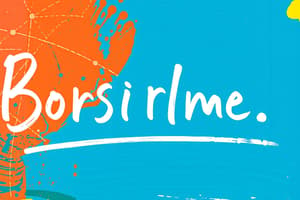Podcast
Questions and Answers
What does it mean to be concise in communication?
What does it mean to be concise in communication?
Being concise means sticking to the point and keeping the message brief.
Identify two examples of filler words that can be removed for conciseness.
Identify two examples of filler words that can be removed for conciseness.
'Definitely' and 'literally' are two examples of filler words that can be eliminated.
What is the primary purpose of business correspondence?
What is the primary purpose of business correspondence?
The primary purpose of business correspondence is to exchange information in a written format for business activities.
How does a concrete message differ from a vague one?
How does a concrete message differ from a vague one?
What is the primary purpose of a follow-up letter?
What is the primary purpose of a follow-up letter?
Name two major types of business correspondence.
Name two major types of business correspondence.
What distinguishes a business letter from a business memo?
What distinguishes a business letter from a business memo?
What information is typically included in a letter of recommendation?
What information is typically included in a letter of recommendation?
What role does correctness play in effective communication?
What role does correctness play in effective communication?
How do acknowledgement letters function?
How do acknowledgement letters function?
Describe what coherent communication entails.
Describe what coherent communication entails.
What is the main objective of a sales letter?
What is the main objective of a sales letter?
In the provided bad example, what is a significant issue related to conciseness?
In the provided bad example, what is a significant issue related to conciseness?
What is the purpose of a cover letter?
What is the purpose of a cover letter?
What key details should an order letter include?
What key details should an order letter include?
What key information should be included in a letter of resignation?
What key information should be included in a letter of resignation?
What is one benefit of using examples in concrete communication?
What is one benefit of using examples in concrete communication?
How should one approach writing a complaint letter?
How should one approach writing a complaint letter?
Why is it important for communication to fit the audience?
Why is it important for communication to fit the audience?
What is the purpose of an adjustment letter?
What is the purpose of an adjustment letter?
What does it mean for communication to be 'clear'?
What does it mean for communication to be 'clear'?
Provide one example of an ineffective communication and explain why it's poor.
Provide one example of an ineffective communication and explain why it's poor.
What is the primary function of inquiry letters?
What is the primary function of inquiry letters?
What are the benefits of following the 7 C's of communication when writing letters?
What are the benefits of following the 7 C's of communication when writing letters?
What key elements should a complete business message include?
What key elements should a complete business message include?
How does courteous communication differ from passive-aggressive tones?
How does courteous communication differ from passive-aggressive tones?
What is the purpose of a 'call to action' in business correspondence?
What is the purpose of a 'call to action' in business correspondence?
What is the average GPA maintained during the school year?
What is the average GPA maintained during the school year?
Contrast the effectiveness of the bad and good examples of messages provided.
Contrast the effectiveness of the bad and good examples of messages provided.
What does it mean for a business communication to be 'complete'?
What does it mean for a business communication to be 'complete'?
How many hours per week does the individual work?
How many hours per week does the individual work?
What is the typing speed of the individual?
What is the typing speed of the individual?
Why is it important to consider the reader's viewpoint in business communication?
Why is it important to consider the reader's viewpoint in business communication?
Identify a key element to improve the clarity of messages in business correspondence.
Identify a key element to improve the clarity of messages in business correspondence.
What role does interpersonal interaction play in the individual's strengths?
What role does interpersonal interaction play in the individual's strengths?
What did the individual build for their senior graduation project?
What did the individual build for their senior graduation project?
In what way can a well-structured email impact team dynamics within an organization?
In what way can a well-structured email impact team dynamics within an organization?
What qualities does the individual say would make them an asset to the organization?
What qualities does the individual say would make them an asset to the organization?
How does the individual prefer to be contacted?
How does the individual prefer to be contacted?
What is one guideline for formatting a letter of application?
What is one guideline for formatting a letter of application?
What is one key reason to proofread your application letter?
What is one key reason to proofread your application letter?
What is the recommended length for a resume?
What is the recommended length for a resume?
What type of font should be used in a resume?
What type of font should be used in a resume?
Why is it important to tailor your resume for each job application?
Why is it important to tailor your resume for each job application?
What is a significant element that should always accompany a resume?
What is a significant element that should always accompany a resume?
Flashcards
Concise Communication
Concise Communication
Using minimal words to communicate the main message clearly. Avoiding unnecessary words or phrases.
Concrete Communication
Concrete Communication
Providing clear and specific details, making the message easy to understand. Aim for a vivid picture in the reader's mind.
Coherent Communication
Coherent Communication
Ensuring all points are connected and flow logically, creating consistency in the message.
Correct Communication
Correct Communication
Signup and view all the flashcards
Eliminating Filler Words
Eliminating Filler Words
Signup and view all the flashcards
Staying on Topic
Staying on Topic
Signup and view all the flashcards
Maintaining Consistency
Maintaining Consistency
Signup and view all the flashcards
Error-free Communication
Error-free Communication
Signup and view all the flashcards
Business Correspondence
Business Correspondence
Signup and view all the flashcards
Business Letter
Business Letter
Signup and view all the flashcards
Business Memo/Memorandum
Business Memo/Memorandum
Signup and view all the flashcards
Order Letter
Order Letter
Signup and view all the flashcards
Complaint Letter
Complaint Letter
Signup and view all the flashcards
Adjustment Letter
Adjustment Letter
Signup and view all the flashcards
Inquiry Letter
Inquiry Letter
Signup and view all the flashcards
Sales Letter
Sales Letter
Signup and view all the flashcards
Follow-Up Letter
Follow-Up Letter
Signup and view all the flashcards
Letter of Recommendation
Letter of Recommendation
Signup and view all the flashcards
Acknowledgement Letter
Acknowledgement Letter
Signup and view all the flashcards
Letter of Resignation
Letter of Resignation
Signup and view all the flashcards
Clear Communication
Clear Communication
Signup and view all the flashcards
Bad Example
Bad Example
Signup and view all the flashcards
Good Example
Good Example
Signup and view all the flashcards
Resume
Resume
Signup and view all the flashcards
Professional/Executive Summary
Professional/Executive Summary
Signup and view all the flashcards
Simple, Standard Font
Simple, Standard Font
Signup and view all the flashcards
Resume Paper
Resume Paper
Signup and view all the flashcards
Opening Paragraph
Opening Paragraph
Signup and view all the flashcards
Second Paragraph
Second Paragraph
Signup and view all the flashcards
Third Paragraph
Third Paragraph
Signup and view all the flashcards
Fourth Paragraph
Fourth Paragraph
Signup and view all the flashcards
Length
Length
Signup and view all the flashcards
Format
Format
Signup and view all the flashcards
Font
Font
Signup and view all the flashcards
Purpose
Purpose
Signup and view all the flashcards
Complete Message
Complete Message
Signup and view all the flashcards
Courteous Communication
Courteous Communication
Signup and view all the flashcards
Business Email
Business Email
Signup and view all the flashcards
Study Notes
Business Correspondence
- Refers to the exchange of information in a written format for business activities
- Occurs between organizations, within organizations, or between organizations and customers
- Generally follows widely accepted, universal formats
Major Types of Business Correspondence
- Business Letters: The most formal method of communication; follows specific formats; addressed to a particular person or organization
- Business Memos/Memorandums: Documents used for internal communication within an organization; often drafted by management and addressed to other employees
- Business Faxes: Been around longer than memos, but less common due to limited access to fax machines
- Business Email: Considered the most important communication method today, although not a replacement for letters
Types of Business Letters
- Sales Letters: Start with a compelling statement to capture the reader's interest; include strong calls to action, benefits of taking action, and helpful information like phone numbers/websites;
- Order Letters: Sent by consumers or businesses to order goods or services; must include specific details such as model number, product name, quantity, and expected price; sometimes include payment information
- Complaint Letters: The words and tone chosen in this letter are crucial; be direct but tactful and maintain a professional tone to maximize the chance of the company responding
- Adjustment Letters: Response to customer claims or complaints; if in the customer's favor, start by acknowledging this; if negative, then keep the tone factual and acknowledge the complaint
- Inquiry Letters: Question or information-seeking; keep it clear and concise, and include required contact details
- Follow-Up Letters: Sent after an initial communication, such as a sales department thanking a customer for an order, a meeting, or a job application status inquiry
- Letters of Recommendation: Used by prospective employers; typically written by previous employers or professors; describes their relationship and opinion of the job seeker
- Acknowledgment Letters: Act as receipts acknowledging communication, but may or may not include action
- Cover Letters: Accompany packages, reports, or merchandise; describe the enclosed items, the reason for sending, and any needed actions to take
- Letters of Resignation: Used by employees planning to leave; provide notice and the last work day, often including the reason for leaving
The 7 C's of Communication
- Clear: Be clear about your goal or message when writing or speaking; know your purpose and ensure clarity for your audience
- Concise: Stick to the point; eliminate needless adjectives and "filler words"
- Concrete: The audience should have a clear picture of what is being communicated; use detailed information, vivid facts and a laser-like focus
- Correct: Grammatically and factually accurate communication suitable for your chosen audience
- Coherent: Logical; all points connect to the topic; consistent tone and flow
- Complete: Audience receives all relevant information needed; includes a 'call for action'
- Courteous: Friendly, open and honest; reader's viewpoint is considered; empathetic to receiver's needs
Resume
- One to two-page formal document
- Lists a job applicant's experience, education, and skills
- Designed to provide a summary of applicant's qualifications
- Not meant to include everything, should be tailored for a particular job
Application Letter Guidelines
- Length: No more than one page
- Format: Single-spaced with a space between paragraphs; 1" margins, and left-aligned text
- Font: Traditional font like Times New Roman, Arial, or Calibri; 10-12 point size
- Important: Proofread and edit carefully; include correct employer/company names to avoid mistakes
Parts of a Business Letter
- Heading: Return address or letterhead; includes organizational information
- Date: Full month, day, and four-digit year
- Inside Address: Recipient's address, including name, company, address, and postal code. If applicable, add a job title and separate it with a comma, ensuring correct spelling
- Greeting: "Dear" followed by recipient's last name; use appropriate formal titles ("Ms.," "Mr.," etc.)
- Body Paragraphs: Detail the writer's purpose and include relevant information
- Complimentary Close: Short, polite closing; typically at the left margin but may be center justified (e.g., "Sincerely," "Yours truly")
- Signature and Writer's Identification: Signature, and optionally, a printed name and job title written below the signature line. Use blue or black ink
Letter Styles
- Full-Block Style: All elements are aligned to the left margin; no indentation
- Modified Block Style: Return address, date, closing, and signature start slightly to the right of center. Body paragraphs start at the left margin
- Indented or Semi-Block Style: Similar to modified block style, with the first line of every paragraph indented
Studying That Suits You
Use AI to generate personalized quizzes and flashcards to suit your learning preferences.
Related Documents
Description
This quiz covers key concepts of effective business communication. It includes questions on the purpose and elements of various types of business correspondence, the significance of conciseness, and the role of correctness and coherence. Test your understanding of how to communicate clearly and effectively in a business setting.




